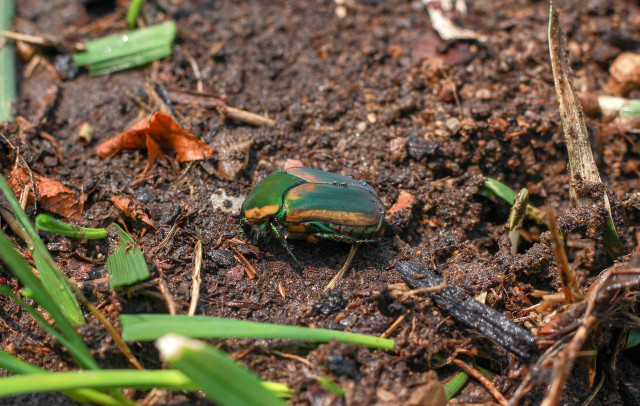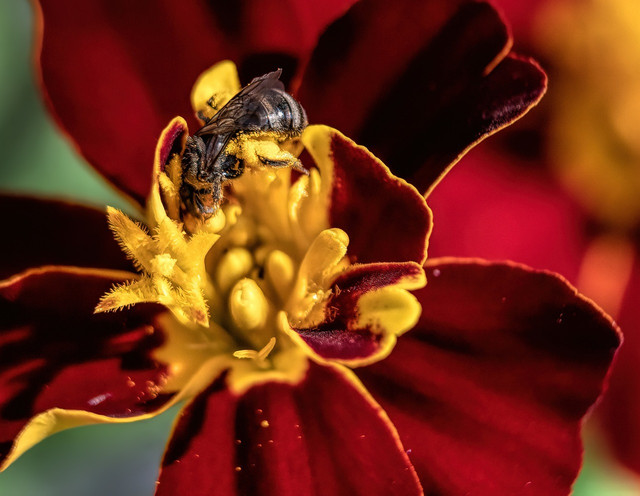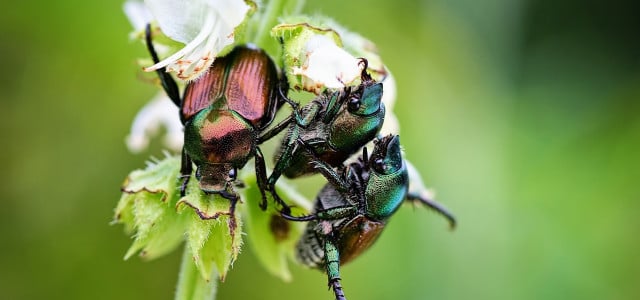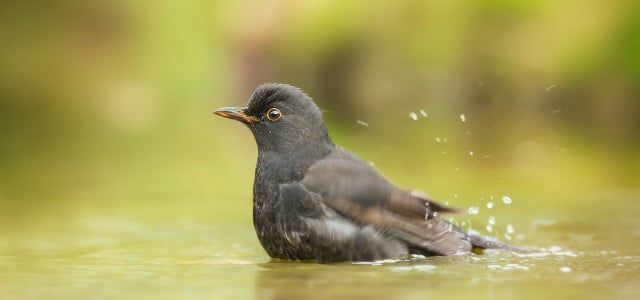Learn how to get rid of pesky June bugs with these three proven methods that are eco-friendly and effective. We’ll show you how to make natural traps, use deterrents, and modify your garden to control the problem.
June bugs, also known as June beetles, can be a nuisance for gardeners. With their compact, oval-shaped body these bugs are easy to identify as they often gather in large numbers, causing damage to plants.
But don’t worry! With these three proven methods for getting rid of June bugs, you’ll save your plants and get back to enjoying your garden in no time. Read on to find out
- how to make natural insect traps,
- the right way to manually remove June bugs, and
- how modifying your garden can control June bug infestations while minimizing harm to beneficial insects and the environment.
Not sure if it’s really June bugs? Use one of these free bug and insect identification apps to be sure!
1. How to Get Rid of June Bugs Using Natural Traps and Deterrents

To effectively deal with June bugs, you can make natural traps and deterrents that are both efficient and environmentally friendly.
Homemade trap for June bugs
To make a simple yet effective trap for June bugs, you will need a few basic materials. This trap utilizes a light source to attract the bugs and a water and soap solution to trap them.
Materials:
- Bucket or large container with steep sides to prevent the June bugs from escaping
- Enough water to fill the bucket about halfway
- A few drops of liquid soap or dishwashing detergent — this will break the surface tension of the water and prevent the bugs from floating and escaping.
Steps:
- Place the trap in an area where you have noticed June bugs or where they are causing damage.
- Place a light over the container to attract the June bugs. Keep the light turned on during the evening or nighttime, when June bugs are most active.
- Regularly inspect the trap, preferably in the morning, and carefully remove any dead June bugs from the water. You can either feed the bugs to chickens or bury them away from plants to keep bugs from coming back.
- Refill the container with fresh water and soap as needed and regularly clean the trap to prevent unpleasant odors and ensure its continued efficiency.
Tips for making traps more effective:
- Set up multiple traps to increase your chances of catching June bugs, particularly if you have a large infestation or a wide area to cover.
- Some people find it works well to add attractants like fruit or fermented substances to improve the effectiveness of the trap. However, this may also attract other insects, so use caution.
- Try placing the trap in different locations to find the best spot.
Natural deterrents for June bugs
Using natural deterrents is an eco-friendly approach to repel June bugs from infesting plants or entering specific areas. These deterrents use smells or tastes that bugs find unpleasant to stop them from being there.
1. Neem oil: Neem oil is derived from the neem tree and has been used for centuries as a natural pesticide and is one of the least toxic insecticides to humans. It contains compounds that repel a wide range of insects, including June bugs, while being very low toxicity to beneficial organisms.
How to use neem oil to deter June bugs:
- Mix neem oil with water according to the instructions on the product label. Usually, a ratio of 1–2 tablespoons of neem oil per gallon of water is recommended.
- Transfer the diluted neem oil solution to a spray bottle. Thoroughly spray the affected plants, focusing on the leaves, stems, and any other areas where June bugs tend to gather.
- Reapply after rainfall or every 7–14 days, depending on the severity of the infestation.
By the way — not only is it not toxic, neem oil is used for skin and as a neem tea. Both don’t come without some risks, though.
2. Garlic spray: Garlic has a strong odor that repels many insects, including June bugs. By making a garlic spray, you can discourage bugs from attacking your plants.
How to make garlic spray to deter June bugs:
- Finely chop or crush several cloves of garlic.
- Place the crushed garlic in a container and add water, allowing it to steep overnight.
- Strain the mixture and transfer the garlic-infused water to a spray bottle.
- Spray the solution liberally on your plants, particularly on the foliage and flowers.
- Reapply every few days or after rainfall.
Learn more: Health Benefits of Raw and Cooked Garlic
3. Essential oils: Certain essential oils can be used to repel bugs thanks to their strong scents. Cedarwood, eucalyptus, and peppermint oils are commonly used for this purpose.
How to use essential oils to deter June bugs:
- Mix a few drops of your chosen essential oil with water in a spray bottle. The exact dilution ratio will depend on the specific oil and its potency. Generally, 5–10 drops per cup of water is a good starting point.
- Shake the spray bottle well to ensure the oil is mixed in and spray the mixture onto plants, focusing on areas prone to infestation or entry points for June bugs.
- Reapply every few days or as needed.
Got pets? Some essential oils can be used for DIY Natural Flea-Repellent Laundry Liquid for Pet Bedding.
Tips for using natural June bug deterrents:
- Apply the deterrents in the evening or early morning when June bugs are less active.
- Pay attention to the undersides of leaves and other places where June bugs can hide.
- Before you apply any deterrent to your whole garden, test it on a small area to see if it affects your plants in any way.
2. Manually Remove June Bugs to Resolve Smaller Infestations



Handpicking June bugs is when you physically remove the bugs from your plants, immediately reducing their numbers and potential damage. This method can be time-consuming but is particularly effective for smaller infestations or targeted areas. Handpicking may need to be repeated periodically, especially during peak June bug activity periods, to effectively manage their population.
Steps for handpicking June bugs:
- Fill a bucket with water and add a few drops of liquid soap or dishwashing detergent. The soap will break the surface tension of the water, preventing the bugs from floating and escaping.
- Gently approach the June bugs on the plants. Take care not to startle them, as they may take flight.
- Using gloved fingers, carefully pick up the June bugs one by one and drop them into the bucket of soapy water. You can also shake the branches or vegetation they are on to dislodge the bugs and guide them into the bucket.
- Discard the trapped bugs, either by feeding them to chickens if you’re lucky enough to have some, or bury them away from plants to prevent their return.
Tips for handpicking June bugs:
- June bugs have spiky legs and can try to bite or pinch you when handled, but they’re not really harmful. Consider wearing gloves or using a small tool, such as tweezers or a spoon.
- June bugs often hide on the undersides of leaves during the day, so take the time to carefully check there.
- Look for bugs that are actively feeding or moving along your plants rather than those that are motionless or inactive, as they are more likely to spring into action and avoid your attempts to remove them. After getting those, you’ll have time to remove the inactive ones.
- Ideally, plan to do the handpicking during the early morning or late evening when June bugs are less active and more sluggish.
3. Modify the Habitat to Get the June Bugs to Leave



Preemptively modifying your garden’s environment and taking precautionary steps to prevent June bugs from causing trouble in your garden is the best way to ensure your garden stays free from these pesky bugs. Follow these tips to help reduce their numbers before they become a problem.
1. Outdoor lighting: June bugs are attracted to bright lights, especially white and ultraviolet lights. Consider using dimmer outdoor lighting or yellow bug lights, which are less attractive to these insects. You should also try to turn off unnecessary lights during the evening and night to minimize light pollution.
2. Moisture management: June bugs are attracted to areas with excess moisture, such as damp soil, standing water, or areas with high humidity. Use proper drainage techniques to reduce moisture accumulation in your garden and avoid overwatering your plants, as damp soil can create an ideal breeding ground for June bugs.
3. Physical barriers: Cover susceptible plants with floating row covers made of lightweight fabric or mesh. These covers act as a physical barrier, preventing June bugs from accessing and damaging your plants. Ensure the barriers are securely fastened to deter the bugs effectively.
4. Encourage natural predators: Certain plants attract natural predators of June bugs, such as birds, frogs, toads, or beneficial insects like ground beetles and parasitic wasps. As well as plants, include features in your garden that attract natural predators, such as birdbaths, bird boxes, and small natural swimming ponds.
5. Garden maintenance: Clean up fallen leaves, grass clippings, and other garden debris regularly. These materials can provide hiding places and breeding grounds for June bugs.
Read more:
- How to Harvest Rhubarb: Avoid These 5 Mistakes
- Fertilize Your Basil Like a Pro: Tips for Growing Healthy, Vibrant Herbs
- 4 Ways to Save and Use Potato Water: Home, Garden, Cooking
Do you like this post?








